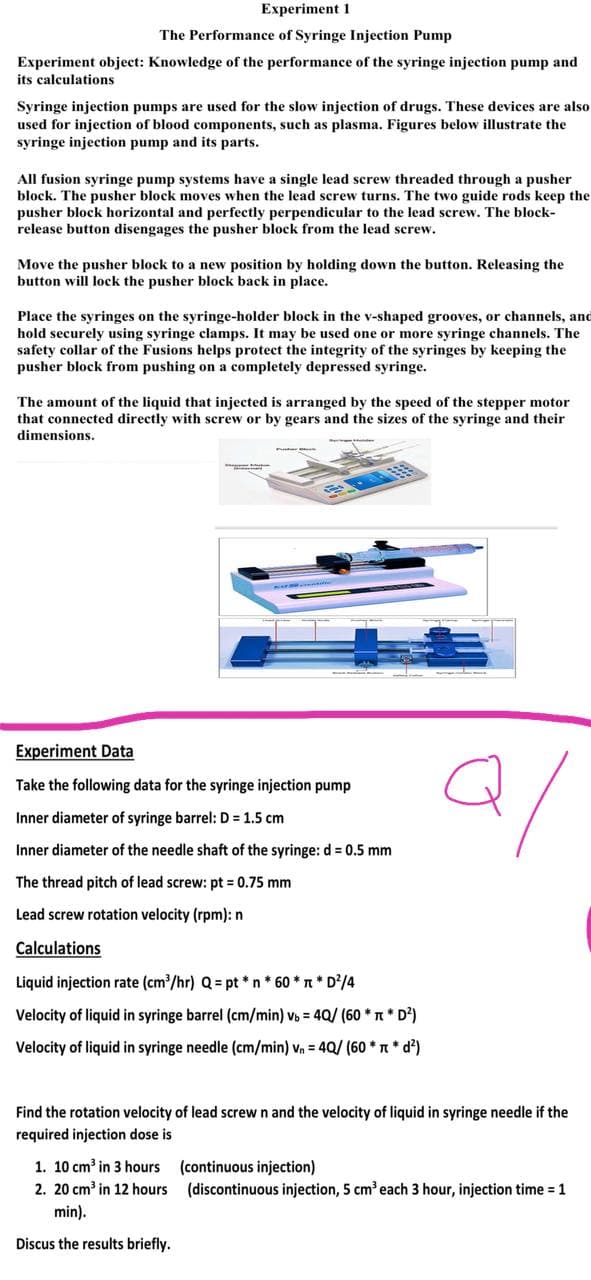Take the following data for the syringe injection pump Inner diameter of syringe barrel: D = 1.5 cm Inner diameter of the needle shaft of the syringe: d = 0.5 mm The thread pitch of lead screw: pt = 0.75 mm Lead screw rotation velocity (rpm): n Calculations Liquid injection rate (cm³/hr) Q = pt*n* 60 * π * D²/4 Velocity of liquid in syringe barrel (cm/min) vb = 4Q/ (60** D²) Velocity of liquid in syringe needle (cm/min) v = 40/ (60** d²)
Take the following data for the syringe injection pump Inner diameter of syringe barrel: D = 1.5 cm Inner diameter of the needle shaft of the syringe: d = 0.5 mm The thread pitch of lead screw: pt = 0.75 mm Lead screw rotation velocity (rpm): n Calculations Liquid injection rate (cm³/hr) Q = pt*n* 60 * π * D²/4 Velocity of liquid in syringe barrel (cm/min) vb = 4Q/ (60** D²) Velocity of liquid in syringe needle (cm/min) v = 40/ (60** d²)
Principles of Heat Transfer (Activate Learning with these NEW titles from Engineering!)
8th Edition
ISBN:9781305387102
Author:Kreith, Frank; Manglik, Raj M.
Publisher:Kreith, Frank; Manglik, Raj M.
Chapter6: Forced Convection Over Exterior Surfaces
Section: Chapter Questions
Problem 6.1DP
Related questions
Question

Transcribed Image Text:Experiment 1
The Performance of Syringe Injection Pump
Experiment object: Knowledge of the performance of the syringe injection pump and
its calculations
Syringe injection pumps are used for the slow injection of drugs. These devices are also
used for injection of blood components, such as plasma. Figures below illustrate the
syringe injection pump and its parts.
All fusion syringe pump systems have a single lead screw threaded through a pusher
block. The pusher block moves when the lead screw turns. The two guide rods keep the
pusher block horizontal and perfectly perpendicular to the lead screw. The block-
release button disengages the pusher block from the lead screw.
Move the pusher block to a new position by holding down the button. Releasing the
button will lock the pusher block back in place.
Place the syringes on the syringe-holder block in the v-shaped grooves, or channels, and
hold securely using syringe clamps. It may be used one or more syringe channels. The
safety collar of the Fusions helps protect the integrity of the syringes by keeping the
pusher block from pushing on a completely depressed syringe.
The amount of the liquid that injected is arranged by the speed of the stepper motor
that connected directly with screw or by gears and the sizes of the syringe and their
dimensions.
Experiment Data
Take the following data for the syringe injection pump
Inner diameter of syringe barrel: D = 1.5 cm
Inner diameter of the needle shaft of the syringe: d = 0.5 mm
The thread pitch of lead screw: pt = 0.75 mm
Lead screw rotation velocity (rpm): n
Calculations
Liquid injection rate (cm³/hr) Q = pt*n* 60 * π * D²/4
Velocity of liquid in syringe barrel (cm/min) vb = 4Q/ (60** D²)
Velocity of liquid in syringe needle (cm/min) v₁ = 4Q/ (60** d²)
Find the rotation velocity of lead screw n and the velocity of liquid in syringe needle if the
required injection dose is
1. 10 cm³ in 3 hours
(continuous injection)
2. 20 cm³ in 12 hours
(discontinuous injection, 5 cm³ each 3 hour, injection time = 1
min).
Discus the results briefly.
Expert Solution
This question has been solved!
Explore an expertly crafted, step-by-step solution for a thorough understanding of key concepts.
This is a popular solution!
Trending now
This is a popular solution!
Step by step
Solved in 2 steps with 3 images

Knowledge Booster
Learn more about
Need a deep-dive on the concept behind this application? Look no further. Learn more about this topic, mechanical-engineering and related others by exploring similar questions and additional content below.Recommended textbooks for you

Principles of Heat Transfer (Activate Learning wi…
Mechanical Engineering
ISBN:
9781305387102
Author:
Kreith, Frank; Manglik, Raj M.
Publisher:
Cengage Learning

Principles of Heat Transfer (Activate Learning wi…
Mechanical Engineering
ISBN:
9781305387102
Author:
Kreith, Frank; Manglik, Raj M.
Publisher:
Cengage Learning